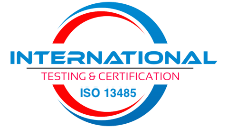
Protective clothing against liquid chemicals – Performance requirements for clothing with liquid-tight (Type 3) or spray-tight (Type 4) connections, including items providing protection to parts of the body only (Types PB [3] and PB [4])
EN 14605 TESTS
This standard specifies performance requirements for clothing with liquid-tight (type 3) or spray-tight (type 4) seams and includes requirements for apparel that provides protection for specific parts of the body only (types PB [3] and PB [4]).
Types 3 and 4: Differences and Applications – Implications of Permeation Testing (EN 374-3 or ISO 6529)
The key difference between types 3 and 4 relates to the pressure and volume of a liquid spray:
•Type 3 is a strong jet of liquid such as that from a pressure sprayer
•Type 4 is a lighter spray such as that from a sprinkler system (i.e., substantial volume but lower in pressure)
In 14605 certification testing, this difference is reflected primarily in the finished garment spray test and not by any comparative mechanical property or by chemical permeation or barrier assessment tests.
Both types 3 and 4 must have sealed seams. EN 14605 requires at least one chemical permeation test on a seam (as well as the fabric) with a minimum score in class 1 (i.e. >10 minutes). No type of stitched seam will achieve this result against any chemical.
Type 3 and 4 certification also requires a permeation test on the fabric against at least one chemical with a minimum score in class 1 (i.e. >10 minutes). This standard does not specify that any particular chemical must be used for this test so, theoretically, a garment could be certified to type 3 or 4 with a permeation test against, for example, water while showing a normalised breakthrough of 11 minutes. However, a fabric with such a poor barrier against water would be unlikely to pass the finished garment spray tests.
Certification to types 3 and 4 does not indicate a general suitability for protection against any specific chemical or a general chemical protective application. An assessment of the permeation barrier against specific chemicals should be made as part of every risk assessment.
Permeation classification:
• Class 1 > 10 min
• Class 2 > 30 min
• Class 3 > 60 min
• Class 4 > 120 min
Specifies the minimum requirements for the following categories of limited-use and reusable chemical protective clothing:
-Full-body protective clothing with jet-tight connections between the different parts of the clothing (Type 3: liquid-tight clothing) and, if applicable, with liquid-tight connections to component parts, such as hoods, gloves, boots, visors or
respiratory protective equipment, which may be specified in other European standards. Examples of such clothing are onepiece coveralls or two-piece suits, with or without gloves, hoods, visors, integrated socks and boot covers.
-Partial body protection garments offering protection against permeation of chemical liquids to specific parts of the body. Examples of such garments are: laboratory coats, jackets, trousers, aprons, sleeves, hoods (without air supply) etc. As partial body protection leaves some parts of the body unprotected, this document only specifies the performance requirements for the clothing material and the seams.
• Class 5 > 240 min
• Class 6 > 480 min
Specifies the minimum requirements for the following categories of limited-use and reusable chemical protective clothing:
-Full-body protective clothing with spray-tight connections between the different parts of the clothing (Type 4: spray-tight clothing) and, if applicable, with spray-tight connections to component parts, such as hoods, gloves, boots, visors or respiratory protective equipment, which may be specified in other European standards. Examples of such clothing are one-piece coveralls or two-piece suits, with or without gloves, hoods, visors, integrated socks and boot covers.
-Partial body protection garments offering protection against permeation of chemical liquids to specific parts of the body. Examples of such garments are: laboratory coats, jackets, trousers, aprons, sleeves, hoods (without air supply) etc. As partial body protection leaves some parts of the body unprotected, this document only specifies the performance requirements for the clothing material and the seams.











